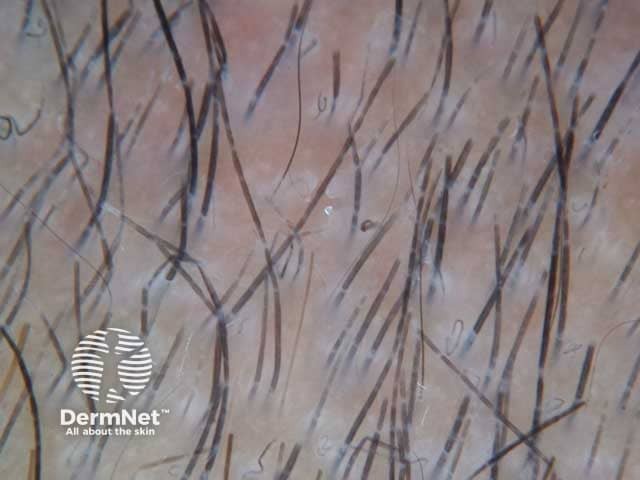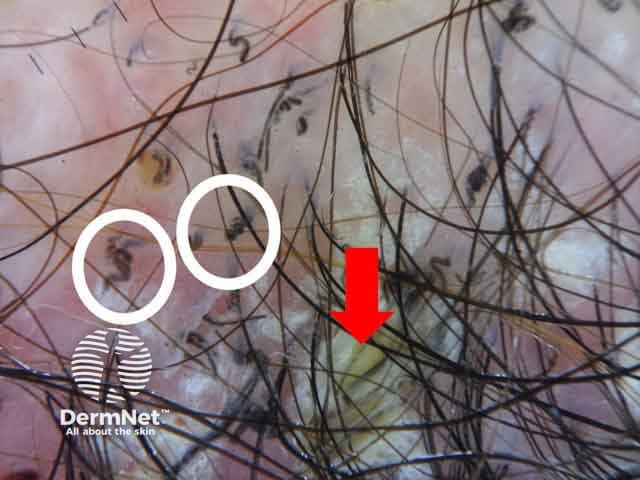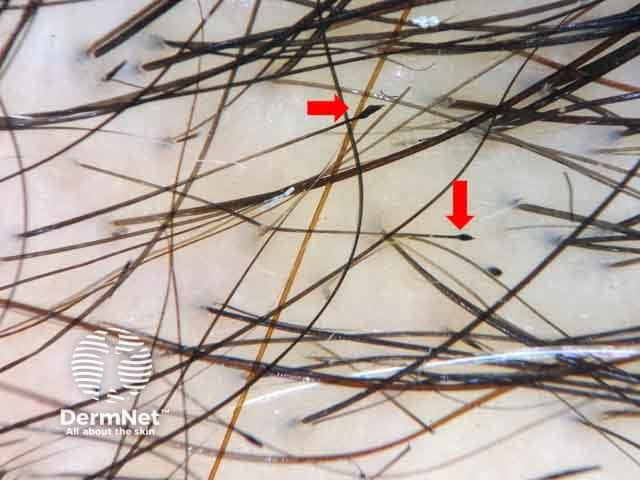Main menu
Common skin conditions

NEWS
Join DermNet PRO
Read more
Quick links
Trichoscopy of localised noncicatricial hair loss — extra information
Follicular disorder Diagnosis and testing
Trichoscopy of localised noncicatricial hair loss
May 2022
Author: Dr Ahmed Sadek, Dermatologist, Cairo Hospital for Dermatology & Venereology (Al-Haud Al-Marsoud), Egypt (2022)
Contributors: Dr Dalia Hossam, Dr Radwa Magdy, Dr Nehal Saied, Dr Noha Hashem, Dr Safaa Yehia Negm, Dr Moshera Saied El Bahrawy, Dr Amira Ragab, Dr Amal Wagih, Dr Haidy El-Hussieny, Dr Mona Ragib, Dr Hala Amer (2022)
Edited by the DermNet content department
Introduction
Alopecia areata
Tinea capitis
Trichotillomania
Traction alopecia
Temporal triangular alopecia
Introduction
Many scalp and hair disorders present with focal hairless patches which require meticulous examination to differentiate between cicatricial (scaring) and noncicatricial (non-scarring) alopecia and to identify their exact cause. Trichoscopy can be used as a non-invasive tool for rapid diagnosis of different types of alopecia.
Main causes of localised noncicatricial alopecia:
- Alopecia Areata (AA)
- Tinea Capitis (TC)
- Trichotillomania (TM)
- Tractional alopecia
- Temporal Triangular Alopecia (TTA).
Alopecia areata
Refer to generalised noncicatricial hair loss for further information on the trichoscopy of alopecia areata.
Tinea capitis
Tinea capitis is a superficial fungal infection of the scalp commonly affecting children, however it may present in immunosuppressed adults. The disease is primarily caused by dermatophytes, Trichophyton and Microsporum genera, that cause endothrix or ectothrix type hair shaft infection respectively.
The clinical presentation is typically of a single or multiple patches of hair loss, sometimes with a black dot pattern, that may be accompanied by inflammation, scaling, pustules, and itching.
Trichoscopic features
Specific features:
- Comma hairs
- Corkscrew hairs.
Comma and corkscrew hairs represent the bending of the affected hair shafts due to the invasion with fungal hyphae.

Dermoscopic image of tinea capitis presenting with comma hairs

Dermoscopic image of tinea capitis presenting with corkscrew hairs

Dermoscopic image showing comma hair (white circles) zigzag hair (black arrows) and morse-code hair (red arrows) denoting tinea capitis (TC-patient1)
Other features:
- Heterogeneous black dots
- Broken and dystrophic hairs
- Zigzag hairs
- Morse code (barcode) hairs are reported: clue of ectothrix infection by Microsporum canis
- White or yellow greasy scales
- Erythematous perifollicular skin, V-shaped hair, crusts, and follicular pustules are observed in inflammatory types
- Follicular keratosis in non-inflammatory type

Dermoscopic image of tinea capitis showing zigzag hairs; focal weakening of the hair shaft in a male child

Dermoscopic image of tinea capitis showing morse code–like hair; interrupted hairs with multiple bands along the hair shaft in a female child.

Dermoscopic image of corkscrew hairs (white circles) with yellowish greasy scales (red arrows) denoting tinea capitis. (TC-patient2)
Trichotillomania
Trichotillomania is a body-focused repetitive behaviour disorder. Sufferers may derive pleasure, gratification, or relief when pulling out their hair. It presents with irregular patches of alopecia, with hairs of variable length commonly affecting the vertex or parietal scalp.
Trichoscopic features
Specific features:
- Hairs broken at different lengths
- Irregular coiled hairs
- Flame figures frequently in early childhood patients
- V-sign
- Hair powder.

Dermoscopic image of trichotillomania showing flame figures; hair remnants of recently pulled hairs

Trichotillomania showing V-sign that represents two hair shafts emerging from the same follicle and cut at the same level

Dermoscopic image showing hair cut at different levels (white arrows), hook hair (black arrows) and flame figures (red arrows) denoting trichotillomania (TTM-patient1)
Other features:
- Heterogeneous black dots
- Hook hairs
- Trichoptilosis
- Extravasated blood
- Tulip hairs
- Upright regrowing hairs
- Yellow dots with cadeverized hair in the center
- Micro–exclamation mark hairs are sometimes described
- Pluck-out sign is described in beard trichotillomania as presence of hemorrhages around the hair follicles
- Less common: comma hairs, crusts, scales, dirty dots, and honeycomb pigment network.

Trichotillomania showing black dots; follicular openings with remnants of pigmented hairs broken at scalp level

Trichotillomania showing hook hair (red arrow)

Dermoscopic image of trichotillomania showing tulip hair; hair shaft with darker distal end
Traction alopecia
Refer to trichoscopy of generalised noncicatricial hair loss for further information on the trichoscopy of tractional alopecia.
Temporal triangular alopecia
Temporal triangular alopecia is a non-scarring, circumscribed alopecia is often located unilaterally in the frontotemporal region during early childhood and remains stationary throughout life.
Trichoscopic features
- Normal follicular openings.
- Vellus hairs of variable length and white hairs are reported.
- Central tuft of terminal hairs may be present in some patients.
- Absent characteristic features suggestive of other disorders.

Clinical image of a male patient with patchy hair loss in the temporal area. (TTA-patient1)

Normal follicular openings with vellus hairs coveirng an area of triangular temporal alopecia. (TTA-patient1)
Bibliography
- Abraham LS, Torres FN, Azulay-Abulafia L. Dermoscopic clues to distinguish trichotillomania from patchy alopecia areata. An Bras Dermatol. 2010;85(5):723–6. doi:10.1590/s0365-05962010000500022. Journal
- Aqil N, BayBay H, Moustaide K, Douhi Z, Elloudi S, Mernissi FZ. A prospective study of tinea capitis in children: making the diagnosis easier with a dermoscope. J Med Case Rep. 2018;12(1):383. Published 2018 Dec 28. doi:10.1186/s13256-018-1914-6. Journal
- Cutrone M, Grimalt R. The Dermoscopic "Pluck Out Sign" for Beard Trichotillomania. Skin Appendage Disord. 2018;4(1):15–17. doi:10.1159/000477588. Journal
- Hughes R, Chiaverini C, Bahadoran P, Lacour JP. Corkscrew hair: a new dermoscopic sign for diagnosis of tinea capitis in black children. Arch Dermatol. 2011;147(3):355–6. doi:10.1001/archdermatol.2011.31. Journal
- Inui S, Nakajima T, Itami S. Temporal triangular alopecia: trichoscopic diagnosis. J Dermatol. 2012;39(6):572–4. doi:10.1111/j.1346-8138.2011.01348.x. Journal
- Karadağ Köse Ö, Güleç AT. Temporal triangular alopecia: significance of trichoscopy in differential diagnosis. J Eur Acad Dermatol Venereol. 2015;29(8):1621-1625. doi:10.1111/jdv.12656. Journal
- Rakowska A, Slowinska M, Olszewska M, Rudnicka L. New trichoscopy findings in trichotillomania: flame hairs, V-sign, hook hairs, hair powder, tulip hairs. Acta Derm Venereol. 2014;94(3):303–6. doi:10.2340/00015555-1674 Journal
- Ross EK, Vincenzi C, Tosti A. Videodermoscopy in the evaluation of hair and scalp disorders. J Am Acad Dermatol. 2006;55(5):799–806. doi:10.1016/j.jaad.2006.04.058. Abstract
- Shim WH, Jwa SW, Song M, et al. Dermoscopic approach to a small round to oval hairless patch on the scalp. Ann Dermatol. 2014;26(2):214-220. doi:10.5021/ad.2014.26.2.214. Journal
- Slowinska M, Rudnicka L, Schwartz RA, et al. Comma hairs: a dermatoscopic marker for tinea capitis: a rapid diagnostic method. J Am Acad Dermatol. 2008;59(5 Suppl):S77-S79. doi:10.1016/j.jaad.2008.07.009. Abstract
On DermNet
- Trichoscopy overview
- Trichoscopy of inflammatory conditions
- Trichoscopy of scalp infestations
- Trichoscopy of generalised noncicatricial hair loss
- Alopecia areata
- Tinea capitis
- Trichotillomania
- Tractional alopecia
- Temporal triangular alopecia
